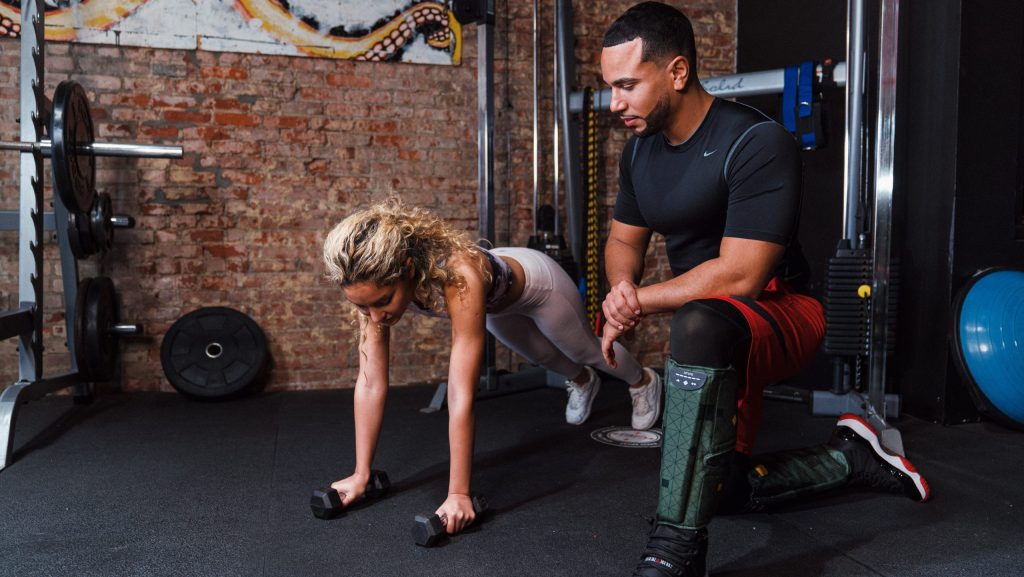Table of Contents
Imagine you’ve been diligently following your fitness regimen, making consistent gains in strength and endurance. Then, out of nowhere, an injury strikes. It’s a scenario all too familiar to many in the fitness world. Whether it’s a sprained ankle from a misstep during a run or a shoulder strain from lifting weights, injuries are not just setbacks; they are also common occurrences that can test your resolve and adaptability.
The challenge is real: In the United States alone, millions of sports and recreation-related injuries are reported annually, affecting seasoned athletes and casual gym-goers alike. But here’s the crucial part: an injury doesn’t have to put a full stop to your fitness journey. It’s about making the right adjustments to continue training effectively, albeit in a modified way.
But the question arises, how does one safely modify a workout routine in the face of injury? This article aims to demystify that process. We’ll delve into the art of tweaking your exercises to suit your body’s current needs, focusing on specific injuries and offering practical solutions to keep you moving. Whether it’s a temporary strain or a more persistent issue, understanding how to adapt your workouts is key to maintaining your fitness and, most importantly, your health.
We start by exploring common workout injuries and the fundamental principles of modifying your workouts to accommodate and recover from these setbacks.
Understanding Common Workout Injuries
In the realm of fitness, injuries like sprains, muscle strains, tendonitis, and joint issues are unfortunately common. These injuries often stem from overuse, where a specific muscle or joint is repeatedly stressed, or from improper technique. Inadequate warm-ups can leave muscles and joints unprepared for exercise, and using inappropriate equipment can also be a contributing factor. Understanding these causes is as important as recognizing the injuries themselves.
Identifying Symptoms and the Long-Term Effects
Recognizing early signs of injury is crucial. Symptoms can range from pain and swelling to reduced mobility. While it’s important to distinguish between normal workout fatigue and injury pain, persistent or worsening pain should never be ignored. Ignoring injuries can lead to more severe, long-term issues like chronic pain or permanent damage. For example, continuing to train on a sprained ankle can lead to recurring problems.
Did You Know? A study found that most gym-related injuries are preventable with proper technique and equipment usage.
Injury Prevention Tips: Effective injury prevention involves several key practices. Proper warm-ups, focusing on technique, gradual progression in workout intensity, and listening to your body’s signals are all critical in avoiding injuries. Remember, prevention is always better than cure.
Transitioning to Workout Modifications: With a solid understanding of the common injuries and their implications, we’re now equipped to explore how to adapt our workouts. Up next, we delve into modifications for upper body injuries, ensuring you stay active and safe.

Tailoring Workouts for Upper Body Injuries
Upper body injuries, such as rotator cuff tears, tennis elbow, and wrist sprains, require careful modification of your workout routine. For strength training, avoid exercises that exacerbate the injury, like heavy bench presses or overhead lifts, especially in cases of shoulder injuries. Opt for lower body workouts or light weights with higher repetitions. 🚴 In terms of cardio, low-impact exercises like brisk walking, cycling, or stationary biking are ideal. These activities maintain cardiovascular health while allowing your upper body to heal.
Using Supportive Equipment and Embracing Mobility Exercises
Supportive equipment, including braces or compression bands, can provide stability to injured areas during workouts. These aids, however, should be used correctly and, ideally, under professional guidance. Alongside, integrating gentle stretching and mobility exercises like yoga or Tai Chi can aid in recovery and maintain flexibility. This dual approach of support and mobility is key in managing upper body injuries effectively.
Did You Know? Regular yoga practice can increase joint flexibility and range of motion, which can be particularly beneficial in recovering from upper body injuries.
Simple Table: Injury Recovery Aids
| Aid Type | Benefits |
|---|---|
| Supportive Braces | Stabilizes injured area |
| Compression Bands | Reduces swelling, supports |
| Gentle Stretching | Increases flexibility |
| Yoga/Tai Chi | Enhances mobility, wellness |
Expert Consultation and Transitioning: Always consult with a healthcare professional or a trained fitness expert for personalized advice on injury management. Their expertise is invaluable in tailoring a safe and effective workout routine.
Adapting Exercises for Lower Body Injuries
Lower body injuries like knee sprains, ankle rolls, and hip strains require thoughtful modifications to your workout routine. For leg workouts, adapt exercises to reduce strain – replace deep squats with partial squats or wall sits for knee injuries, or try stationary biking for ankle issues. Alongside these modifications, incorporating non-impact cardio exercises is crucial. Swimming and using an elliptical machine are excellent options that maintain cardiovascular health while accommodating your injury.
Rehabilitation and Supportive Measures
Rehabilitation exercises play a pivotal role in the healing process. Gentle stretches, calf raises, and straight-leg raises not only strengthen the injured area but also enhance mobility. In certain situations, assistive devices like knee braces or orthotic insoles can provide additional support during your workouts. However, selecting the right type and using them appropriately is key.
Tip: Always start rehabilitation exercises with low intensity and increase gradually as your injury heals.
Consulting Health Professionals: The guidance of healthcare professionals is indispensable for a safe and effective recovery plan. They can offer tailored advice on exercise modifications and recovery strategies specific to your injury and fitness level.
Transitioning to Core and Back Injuries: With insights into adapting lower body workouts, our next focus is on injuries affecting the core and back. This is essential, as lower body injuries can sometimes impact these areas, necessitating a comprehensive approach to workout modifications.

Core and Back Injury Adjustments
Injuries to the core and back, like lumbar strains or herniated discs, necessitate careful adjustment of exercises. For core modifications, opt for safe strengthening exercises like planks, which are less likely to aggravate lower back pain compared to sit-ups. Similarly, for back injuries, incorporate gentle stretches and light back extensions, avoiding movements involving twisting or heavy lifting. Both types of exercises aim to strengthen and stabilize the injured area while minimizing the risk of exacerbation.
Incorporating Gentle Movement and Utilizing Supportive Equipment
Practices like yoga or Pilates are excellent for both core and back injuries, offering a blend of gentle movement and stretching that aids in recovery. These activities not only improve flexibility but also help in reducing pain. Additionally, using supportive equipment like lumbar support belts or stability balls can provide extra support during workouts, but it’s crucial to use them correctly.
Tip: When using stability balls for core and back exercises, ensure proper sizing. Your feet should be flat on the ground, and knees at a 90-degree angle when seated.
Simple Table: Recommended Exercises for Core and Back Injuries
| Exercise Type | Benefits |
|---|---|
| Planks | Strengthens core, reduces back strain |
| Gentle Stretching | Increases flexibility, reduces pain |
| Yoga/Pilates | Enhances stability, aids recovery |
Consulting Health Professionals: Always remember, consulting with healthcare professionals is essential. They can offer personalized exercise modifications and guide you through a recovery plan suited to your specific injury and fitness level.
Transitioning to Injury Prevention: With insights on adapting workouts for core and back injuries, our next focus is integrating injury prevention strategies into routine workouts. This proactive approach is crucial for overall fitness health and avoiding future injuries.
Combining Warm-Up, Cool-Down, and Correct Technique
The cornerstone of injury prevention lies in effective warm-ups, cool-downs, and using the correct technique. Start every workout with dynamic stretches or light cardio to prepare your body, and end with static stretching or relaxation to aid recovery. Paying close attention to your exercise form is equally important; improper technique can lead to injuries and reduce the efficacy of your workout.
Emphasizing Balanced Routines and Listening to Your Body
A balanced workout regimen that incorporates strength, flexibility, and cardio is key to preventing overuse injuries. Variety not only prevents stress on specific muscle groups but also keeps your routine engaging. Equally crucial is listening to your body. Recognize the signs of overtraining and give yourself permission to rest and recover when needed.
Tip: Incorporate at least one rest day per week in your routine to allow for muscle recovery and prevent overuse injuries.
Regular Health Check-Ups and Protective Gear
Staying injury-free also involves regular health check-ups, especially for those with previous injuries. These consultations can help in early detection and management of potential issues. Additionally, using the right protective gear and ensuring your equipment is in top condition are practical steps in safeguarding against injuries.
Incorporating these injury prevention strategies into your workouts is not just about avoiding setbacks; it’s about fostering a healthy, long-term approach to fitness. As we move towards concluding our guide, we’ll recap the key points discussed and provide a final summary on adapting workouts for specific injuries.